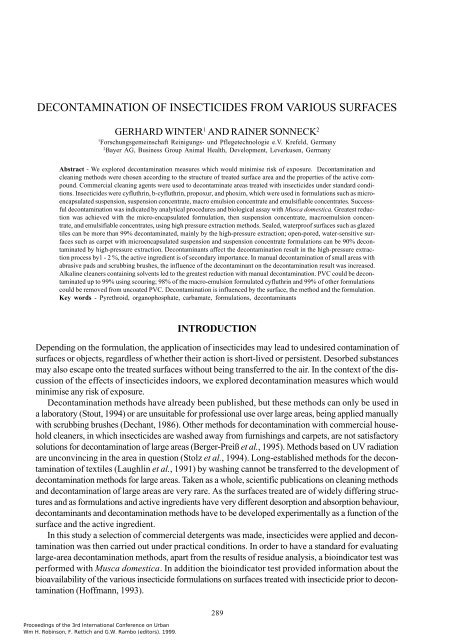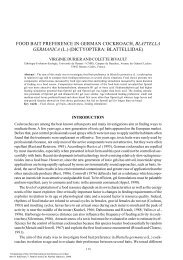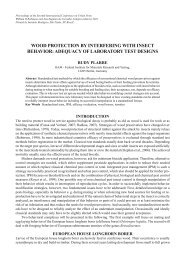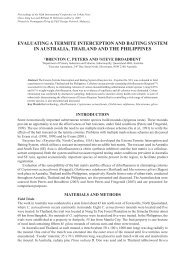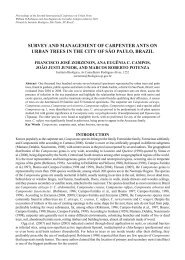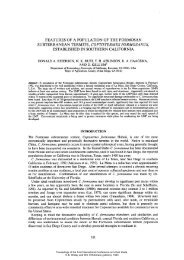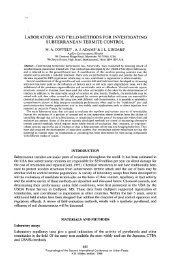decontamination of insecticides from various surfaces
decontamination of insecticides from various surfaces
decontamination of insecticides from various surfaces
You also want an ePaper? Increase the reach of your titles
YUMPU automatically turns print PDFs into web optimized ePapers that Google loves.
DECONTAMINATION OF INSECTICIDES FROM VARIOUS SURFACES<br />
GERHARD WINTER 1 AND RAINER SONNECK 2<br />
1<br />
Forschungsgemeinschaft Reinigungs- und Pflegetechnologie e.V. Krefeld, Germany<br />
2<br />
Bayer AG, Business Group Animal Health, Development, Leverkusen, Germany<br />
Abstract - We explored <strong>decontamination</strong> measures which would minimise risk <strong>of</strong> exposure. Decontamination and<br />
cleaning methods were chosen according to the structure <strong>of</strong> treated surface area and the properties <strong>of</strong> the active compound.<br />
Commercial cleaning agents were used to decontaminate areas treated with <strong>insecticides</strong> under standard conditions.<br />
Insecticides were cyfluthrin, b-cyfluthrin, propoxur, and phoxim, which were used in formulations such as microencapsulated<br />
suspension, suspension concentrate, macro emulsion concentrate and emulsifiable concentrates. Successful<br />
<strong>decontamination</strong> was indicated by analytical procedures and biological assay with Musca domestica. Greatest reduction<br />
was achieved with the micro-encapsulated formulation, then suspension concentrate, macroemulsion concentrate,<br />
and emulsifiable concentrates, using high pressure extraction methods. Sealed, waterpro<strong>of</strong> <strong>surfaces</strong> such as glazed<br />
tiles can be more than 99% decontaminated, mainly by the high-pressure extraction; open-pored, water-sensitive <strong>surfaces</strong><br />
such as carpet with microencapsulated suspension and suspension concentrate formulations can be 90% decontaminated<br />
by high-pressure extraction. Decontaminants affect the <strong>decontamination</strong> result in the high-pressure extraction<br />
process by1 - 2 %, the active ingredient is <strong>of</strong> secondary importance. In manual <strong>decontamination</strong> <strong>of</strong> small areas with<br />
abrasive pads and scrubbing brushes, the influence <strong>of</strong> the decontaminant on the <strong>decontamination</strong> result was increased.<br />
Alkaline cleaners containing solvents led to the greatest reduction with manual <strong>decontamination</strong>. PVC could be decontaminated<br />
up to 99% using scouring; 98% <strong>of</strong> the macro-emulsion formulated cyfluthrin and 99% <strong>of</strong> other formulations<br />
could be removed <strong>from</strong> uncoated PVC. Decontamination is influenced by the surface, the method and the formulation.<br />
Key words - Pyrethroid, organophosphate, carbamate, formulations, decontaminants<br />
INTRODUCTION<br />
Depending on the formulation, the application <strong>of</strong> <strong>insecticides</strong> may lead to undesired contamination <strong>of</strong><br />
<strong>surfaces</strong> or objects, regardless <strong>of</strong> whether their action is short-lived or persistent. Desorbed substances<br />
may also escape onto the treated <strong>surfaces</strong> without being transferred to the air. In the context <strong>of</strong> the discussion<br />
<strong>of</strong> the effects <strong>of</strong> <strong>insecticides</strong> indoors, we explored <strong>decontamination</strong> measures which would<br />
minimise any risk <strong>of</strong> exposure.<br />
Decontamination methods have already been published, but these methods can only be used in<br />
a laboratory (Stout, 1994) or are unsuitable for pr<strong>of</strong>essional use over large areas, being applied manually<br />
with scrubbing brushes (Dechant, 1986). Other methods for <strong>decontamination</strong> with commercial household<br />
cleaners, in which <strong>insecticides</strong> are washed away <strong>from</strong> furnishings and carpets, are not satisfactory<br />
solutions for <strong>decontamination</strong> <strong>of</strong> large areas (Berger-Preiß et al., 1995). Methods based on UV radiation<br />
are unconvincing in the area in question (Stolz et al., 1994). Long-established methods for the <strong>decontamination</strong><br />
<strong>of</strong> textiles (Laughlin et al., 1991) by washing cannot be transferred to the development <strong>of</strong><br />
<strong>decontamination</strong> methods for large areas. Taken as a whole, scientific publications on cleaning methods<br />
and <strong>decontamination</strong> <strong>of</strong> large areas are very rare. As the <strong>surfaces</strong> treated are <strong>of</strong> widely differing structures<br />
and as formulations and active ingredients have very different desorption and absorption behaviour,<br />
decontaminants and <strong>decontamination</strong> methods have to be developed experimentally as a function <strong>of</strong> the<br />
surface and the active ingredient.<br />
In this study a selection <strong>of</strong> commercial detergents was made, <strong>insecticides</strong> were applied and <strong>decontamination</strong><br />
was then carried out under practical conditions. In order to have a standard for evaluating<br />
large-area <strong>decontamination</strong> methods, apart <strong>from</strong> the results <strong>of</strong> residue analysis, a bioindicator test was<br />
performed with Musca domestica. In addition the bioindicator test provided information about the<br />
bioavailability <strong>of</strong> the <strong>various</strong> insecticide formulations on <strong>surfaces</strong> treated with insecticide prior to <strong>decontamination</strong><br />
(H<strong>of</strong>fmann, 1993).<br />
289
290 Gerhard Winter, Rainer Sonneck<br />
MATERIALS AND METHODS<br />
Surfaces<br />
The choice <strong>of</strong> <strong>surfaces</strong> was made according to subject-specific criteria, in the kitchen and living area in<br />
particular. PVC floor covering, glazed tiles, painted plywood, formica and carpet were chosen as representative<br />
<strong>surfaces</strong>.<br />
Decontaminants and cleaning equipment<br />
Commercial products <strong>from</strong> the pr<strong>of</strong>essional cleaning industry were used as decontaminants, according<br />
to their suitability for specific <strong>surfaces</strong>. The equipment and machinery for <strong>decontamination</strong> were chosen<br />
for compatibility with the <strong>surfaces</strong>, so that no damage was caused to the <strong>surfaces</strong> after <strong>decontamination</strong>.<br />
Table 1. Materials used for the <strong>decontamination</strong>.<br />
Decontaminants<br />
Composition<br />
Multi-purpose cleaner Ammonia (25 %) 1,2 %, isopropanol 5 %,NTA-Na salt 6 %<br />
Alcohol cleaner Alkyl sulfonate < 20 %, NTA-Na salt < 20 %, isopropanol 10-15 %<br />
Spray extraction detergent Non-ionic surfactants < 5%, aliphatic hydrocarbons 5-15 %,<br />
care components, water-soluble solvents<br />
Textile shampoo<br />
Anionic surfactants < 5 %, care components<br />
Basic cleaner Fatty alcohol polyglycol ether < 20 %, butyl glycol < 12,5 %,<br />
potassium hydroxide 0,5-1 %, diethylene glycol monobutyl ether<br />
< 20 %, NTA-Na salt < 20 %, diethanolamine < 10 %<br />
Table 2. Machines and equipment used for <strong>decontamination</strong>.<br />
Machine Type Equipment<br />
High-pressure spray Multi Cleaner MC 600 WDB nozzle<br />
extraction cleaner<br />
High pressure spray MC 600 roller brush spray extraction<br />
extraction cleaner extension PW 20<br />
Scrubbing vacuum cleaner BR 400 -<br />
Vacuum cleaner TBS 35 e micr<strong>of</strong>ilter<br />
Low-pressure spray PUZZI S -<br />
extraction cleaner<br />
Scrubbing vacuum cleaner BS 350 -<br />
Insecticides and formulations<br />
In the choice <strong>of</strong> <strong>insecticides</strong> and their formulation, care was taken to cover the widest possible range <strong>of</strong><br />
chemical active ingredient categories. The products used were pyrethroids such as cyfluthrin, betacyfluthrin,<br />
an organophosphate such as phoxim and a carbamate such as propoxur.
Decontamination <strong>of</strong> <strong>insecticides</strong> <strong>from</strong> <strong>various</strong> <strong>surfaces</strong><br />
291<br />
The formulations selected were EC (emulsifiable concentrate), EW (emulsion, oil-in-water), SC<br />
(suspension concentrate) and CS (capsule suspension). All the insecticide formulations were mixed<br />
with water according to the manufacturer’s instructions before application and then applied to the <strong>surfaces</strong>.<br />
Table 3. Application rates <strong>of</strong> <strong>insecticides</strong> prior to <strong>decontamination</strong><br />
Insecticides Active Ingredient A.I. ml/50 ml A.I. application rate<br />
Trade names concentration spray solution (mg/m²)<br />
Solfac ® CS 60 g Cyfluthrin/l 0.6 36<br />
Solfac ® EW 50 g Cyfluthrin/l 0.4 20<br />
Responsar ® SC 125 ß-Cyfluthrin/l 0.1 12.5<br />
Blattanex ® EC 200 g Propoxur/l 1.25 250<br />
Baythion ® EC 500 g Phoxim/l 0.1 50<br />
Decontamination procedure<br />
Various <strong>surfaces</strong> measuring 2 m x 1 m were sprayed with 100 ml insecticide solution prepared ready for<br />
use. Decontamination was carried out on the following day. The temperature in the test rooms was<br />
between 18 and 21ºC and the relative air humidity between 35 and 52%.<br />
High-pressure extraction method for water-resistant <strong>surfaces</strong> such as glazed tiles, Formica<br />
and painted wood<br />
The decontaminants multi-purpose cleaner and alcohol cleaner were first diluted to 2.5%. The <strong>decontamination</strong><br />
solution was then placed in the clean water tank <strong>of</strong> the MC 600. The machine was fitted with<br />
the WDB nozzle. The <strong>decontamination</strong> solution was sprayed onto the panels at a pressure <strong>of</strong> 50 bar, and<br />
was left for a short time to take effect. At the second stage the spray extraction solution was applied and<br />
vacuumed up simultaneously. In the next operation the clean water tank was emptied, rinsed and filled<br />
with clean water. To remove residues <strong>of</strong> detergent <strong>from</strong> the panels water was applied and then vacuumed<br />
up again immediately.<br />
The grouting between the glazed tiles was soaked with water before application <strong>of</strong> the insecticide in<br />
order to prevent the insecticide <strong>from</strong> migrating into the grouting compound.<br />
Scrubbing vacuum method for PVC<br />
The alkaline basic cleaner (pH = 12.1) was applied with a cloth. After a contact period <strong>of</strong> 10 minutes<br />
it was scrubbed with the scrubbing vacuum cleaner BS 350 with a dark green pad. The floor was gone<br />
over twice in overlapping figures <strong>of</strong> eight, with the suction lips in the raised position. The suction lips<br />
were then lowered and the basic cleaner solution was vacuumed up. The operation was repeated<br />
once and the pad was then removed and cleaned, the dirty solution tank was emptied and the detergent<br />
tank filled with clean water. The operation was repeated twice with water, first scrubbing and then<br />
vacuuming.<br />
Low-pressure spray extraction for textile coverings<br />
First the short pile velvet carpet made <strong>from</strong> polyamide with textile backing was thoroughly vacuumed<br />
with the TBS 35e brush vacuum cleaner. A 10% <strong>decontamination</strong> solution was prepared with the carpet<br />
cleaner. The equipment used was the PUZZI S spray extraction cleaner. The <strong>decontamination</strong> solution<br />
was placed in the clean water tank and the carpet was sprayed with it in parallel overlapping strips.<br />
The suction tool was not placed on the surface. After a contact time <strong>of</strong> approx. 5 minutes the floor was
292 Gerhard Winter, Rainer Sonneck<br />
gone over, with the <strong>decontamination</strong> solution sprayed on again at 4-5 bar and then vacuumed up simultaneously.<br />
The dirty water tank was emptied and the clean water tank rinsed out and filled with clean<br />
water. The floor was gone over twice more with simultaneous spraying and vacuuming, in order to remove<br />
any remaining spray extraction solution. Further vacuuming was intended to ensure that the carpet<br />
retained as little moisture as possible and therefore dried more quickly. After drying, the carpet was vacuumed<br />
again with a brush vacuum cleaner.<br />
High pressure spray extraction for textile coverings<br />
The textile covering was first vacuumed thoroughly with a brush vacuum cleaner TBS 35. A 2.5% <strong>decontamination</strong><br />
solution <strong>of</strong> the spray extraction detergent was applied with the spray extraction machine.<br />
The MC600 was used for spray extraction. The PW 20 spray extraction tool consists <strong>of</strong> a rotating brush<br />
roller, three wide-angle nozzles and a suction nozzle. It was therefore possible to spray, brush and<br />
vacuum in one operation. The brush roller helps to work the <strong>decontamination</strong> solution in deeply and thus<br />
to achieve a more intensive action.<br />
The 2.5% <strong>decontamination</strong> solution was placed in the clean water tank and first sprayed on at 20 bar<br />
and worked in with the brush. After approx. 5 minutes’ contact time more solution was applied by going<br />
over the floor and this was vacuumed up simultaneously. The clean water tank was emptied, rinsed and<br />
filled with clean water and the carpet was rinsed twice more with water with rotating brush. It was then<br />
vacuumed to allow the floor to dry more quickly. After the carpet had dried it was run over again with<br />
a brush vacuum cleaner.<br />
Shampooing and spray extraction <strong>of</strong> textile coverings<br />
The carpet was first vacuumed thoroughly with the brush vacuum cleaner. The shampoo was worked<br />
into the surface with the scrubbing vacuum cleaner BR 400 which was fitted with shampoo brushes.<br />
After a contact time <strong>of</strong> approx. 5 minutes the water was extracted <strong>from</strong> the carpet with the PUZZI S<br />
low-pressure spray extraction machine. For this it was sprayed and vacuumed simultaneously twice.<br />
When the carpet was completely dry it was again vacuumed thoroughly with the brush vacuum cleaner.<br />
ANALYTICAL METHODS<br />
Residue analysis tests with the DC/AMD-TLC (Automated Multiple Development) method<br />
After <strong>decontamination</strong> <strong>of</strong> the 2 m x 1 m areas, panels measuring 15 cm x 15 cm were sawn out at three<br />
different points and after appropriate extraction on HPTLC silica gel plates the active ingredient residue<br />
was determined as a percentage <strong>of</strong> the application solution by the AMD-TLC method (Burger,<br />
1988). The carpet was first prepared by an HPLC separation before the AMD separation was performed.<br />
Bioindication method with Musca domestica<br />
To test the residue three baskets each with 20 female flies <strong>of</strong> the species Musca domestica were placed<br />
on each 2 m 2 surface. The flies were fed with cotton wool pads soaked in sugar water. A control (surface<br />
treated with detergent) and a positive control (surface treated with insecticide without <strong>decontamination</strong>)<br />
were also set up. The survival rates were measured after 1 h and after 24 h following the method<br />
described by H<strong>of</strong>fmann (1993).<br />
RESULTS<br />
High-pressure extraction – tiles, Formica<br />
In the high-pressure extraction process with the multi-purpose cleaner AZ 70 on glazed tiles the <strong>decontamination</strong><br />
was over 99% reduction for all active ingredients and formulations (Table 4). Depending on<br />
the formulation the active ingredient reductions achieved in the high-pressure extraction process with the
Decontamination <strong>of</strong> <strong>insecticides</strong> <strong>from</strong> <strong>various</strong> <strong>surfaces</strong><br />
293<br />
multi-purpose cleaner on Formica were between 85% for Solfac EW and over 99% for Solfac CS with<br />
the alcohol cleaner (Table 5). This is documented by the fly test in Table 5, where the lowest values were<br />
achieved with Solfac CS with a 0% mortality rate and Responsar SC with a 10% mortality rate after 24<br />
hours.<br />
Table 4. Decontamination <strong>of</strong> glazed tile. Decontamination was performed with the multi-purpose<br />
cleaner by the <strong>decontamination</strong> procedure MC 600. After treatment 0, resp. 5% <strong>of</strong> Musca are dead<br />
after 1, resp. 24 hours. The values for the Musca are given in % mortality.<br />
Insecticide Active Reduction % Mortality (before % Mortality (after<br />
ingredient in a.i. (%) <strong>decontamination</strong>) <strong>decontamination</strong>)<br />
mean value 1 hr 24 hr 1 hr 24 hr<br />
Solfac CS Cyfluthrin > 99 20 90 0 0<br />
Solfac EW Cyfluthrin > 99 100 100 0 10<br />
Responsar SC ß-Cyfluthrin > 99 100 100 0 0<br />
Blattanex EC Propoxur > 99 45 90 0 0<br />
Baythion EC Phoxim > 99 75 100 0 0<br />
The mortality rate for Musca domestica was 0% for all <strong>insecticides</strong> with the exception <strong>of</strong> Solfac EW<br />
5%. Residue analysis on the grouting compound produced values below 1 mg/kg grouting compound.<br />
Table 5. Decontamination <strong>of</strong> Formica. Decontamination was performed with the multi-purpose cleaner<br />
by the <strong>decontamination</strong> procedure MC 600. After treatment 0, resp. 5% <strong>of</strong> Musca are dead after 1,<br />
resp. 24 hours. The values for the Musca are given in % mortality.<br />
Insecticide Active Reduction % Mortality (before % Mortality (after<br />
ingredient in a.i. (%) <strong>decontamination</strong>) <strong>decontamination</strong>)<br />
mean value 1 hr 24 hr 1 hr 24 hr<br />
Solfac CS Cyfluthrin 98 0 100 0 0<br />
Solfac EW Cyfluthrin 85 100 100 10 30<br />
Responsar SC ß-Cyfluthrin 89 5 100 0 10<br />
Blattanex EC Propoxur 95 30 80 10 38<br />
Baythion EC Phoxim 94 45 100 30 70<br />
Painted wood<br />
In the <strong>decontamination</strong> <strong>of</strong> painted wood in the high-pressure extraction process with an alcohol cleaner,<br />
an insecticide reduction <strong>of</strong> over 99% was achieved except with the active ingredients formulated as EC<br />
(Table 6). The bioindication test with Musca domestica (Table 6) also showed no increase in mortality<br />
rates. Baythion EC had no effect on Musca domestica in the positive control.
294 Gerhard Winter, Rainer Sonneck<br />
Table 6. Decontamination <strong>of</strong> painted wood. Decontamination was performed with an alcohol cleaner<br />
by the <strong>decontamination</strong> procedure MC 600. After treatment with an alcohol cleaner 0, resp. 5% <strong>of</strong><br />
Musca are dead after 1, resp. 24 hours. The values for the Musca are given in % mortality.<br />
Insecticide Active Reduction % Mortality (before % Mortality (after<br />
ingredient in a.i. (%) <strong>decontamination</strong>) <strong>decontamination</strong>)<br />
mean value 1 hr 24 hr 1 hr 24 hr<br />
Solfac CS Cyfluthrin > 99 10 100 0 5<br />
Solfac EW Cyfluthrin 99 50 100 0 5<br />
Responsar SC ß-Cyfluthrin > 99 10 100 0 10<br />
Blattanex EC Propoxur 95 5 80 0 15<br />
Baythion EC Phoxim 94 0 0 0 0<br />
Scrubbing vacuum, PVC<br />
On coated PVC after removal <strong>of</strong> the protective film a reduction in insecticide <strong>of</strong> over 99% was<br />
achieved in the scrubbing/vacuuming process with a basic cleaner for all active ingredient formulations.<br />
The bioindication test also showed no mortality for houseflies. On uncoated PVC the active ingredient<br />
reduction was over 99% with the exception <strong>of</strong> Solfac EW with 98% and Responsar SC with 99% (Table<br />
7). The bioindication test resulted in mortality rates <strong>of</strong> 5% and under. Only in the case <strong>of</strong> Blattanex<br />
EC was a mortality rate <strong>of</strong> 20% determined.<br />
Table 7. Decontamination <strong>of</strong> uncoated PVC. Decontamination was performed with a basic cleaner by<br />
the <strong>decontamination</strong> procedure BS 350. After treatment with a basic cleaner 0% <strong>of</strong> Musca are dead<br />
after 1, resp. 24 hours. The values for the Musca are given in % mortality.<br />
Insecticide Active Reduction % Mortality (before % Mortality (after<br />
ingredient in a.i. (%) <strong>decontamination</strong>) <strong>decontamination</strong>)<br />
mean value 1 hr 24 hr 1 hr 24 hr<br />
Solfac CS Cyfluthrin > 99 10 100 0 0<br />
Solfac EW Cyfluthrin 98 30 100 0 5<br />
Responsar SC ß-Cyfluthrin 99 10 100 0 3<br />
Blattanex EC Propoxur > 99 0 90 0 20<br />
Baythion EC Phoxim > 99 10 10 0 0<br />
Textile coverings, high- and low -pressure extraction<br />
The reduction in active ingredient achieved with the low-pressure spray extraction method was between<br />
53% for Blattanex EC and 86% for Solfac EW (Table 8). The 96% reduction in active ingredient for<br />
Baythion EC is exceptional. The fly mortality rates after 24 h were between 13% for Baythion EC and<br />
65% for Solfac EW (Table 8). With the high-pressure spray extraction method using the spray extraction<br />
detergent, the reduction in active ingredient achieved was 90% for Solfac CS and 88% for<br />
Responsar SC. Resultant mortality rates after 24 hours in the housefly bioindicator test were 5% for<br />
Solfac CS and 13% for Responsar SC (Table 9).
Decontamination <strong>of</strong> <strong>insecticides</strong> <strong>from</strong> <strong>various</strong> <strong>surfaces</strong><br />
295<br />
Table 8. Decontamination <strong>of</strong> velvet carpet. Decontamination was performed with a spray extraction<br />
detergent by the <strong>decontamination</strong> procedure Puzzi S. After treatment with a spray extraction detergent 0,<br />
resp. 5% <strong>of</strong> Musca are dead after 1, resp. 24 hours. The values for the Musca are given in % mortality.<br />
Insecticide Active Reduction % Mortality (before % Mortality (after<br />
ingredient in a.i. (%) <strong>decontamination</strong>) <strong>decontamination</strong>)<br />
mean value 1 hr 24 hr 1 hr 24 hr<br />
Solfac EW Cyfluthrin 86 100 100 25 65<br />
Solfac CS Cyfluthrin 84 90 100 12 20<br />
Responsar SC ß-Cyfluthrin 59 90 100 8 25<br />
Blattanex EC Propoxur 53 10 60 0 22<br />
Baythion EC Phoxim 96 0 100 0 13<br />
Shampoo<br />
After shampooing the carpet the reduction in active ingredient was 88% for Solfac CS and 69% for<br />
Responsar SC (Table 10); the fly mortality rates for Responsar SC were 17% and for Solfac CS 10%<br />
(Table 10).<br />
Table 9. Decontamination <strong>of</strong> velvet carpet. Decontamination was performed with a spray extraction<br />
detergent by the <strong>decontamination</strong> procedure high pressure extraction. After treatment with a spray<br />
extraction detergent 0%, resp. 5 % <strong>of</strong> Musca are dead after 1, resp. 24 hours. The values for the Musca<br />
are given in % mortality.<br />
Insecticide Active Reduction % Mortality (before % Mortality (after<br />
ingredient in a.i. (%) <strong>decontamination</strong>) <strong>decontamination</strong>)<br />
mean value 1 hr 24 hr 1 hr 24 hr<br />
Solfac CS Cyfluthrin 90 90 100 2 5<br />
Responsar SC ß-Cyfluthrin 88 90 100 0 13<br />
Table 10. Decontamination <strong>of</strong> velvet carpet. Decontamination was performed with textile shampoo by<br />
the <strong>decontamination</strong> method BR 400. After treatment with Shampoo 0% <strong>of</strong> Musca are dead after 1,<br />
resp. 24 hours. The values for the Musca are given in % mortality.<br />
Insecticide Active Reduction % Mortality (before % Mortality (after<br />
ingredient in a.i. (%) <strong>decontamination</strong>) <strong>decontamination</strong>)<br />
mean value 1 hr 24 hr 1 hr 24 hr<br />
Solfac CS Cyfluthrin 88 90 100 0 10<br />
Responsar SC ß-Cyfluthrin 69 90 100 0 17<br />
DISCUSSION<br />
In the <strong>decontamination</strong> <strong>of</strong> glazed tiles a reduction in insecticide <strong>of</strong> over 99% was achieved with all active<br />
ingredients and formulations, which can be attributed to the sealed, solvent-pro<strong>of</strong> surface. The
296 Gerhard Winter, Rainer Sonneck<br />
grouting can be protected against penetration <strong>of</strong> the formulation components by pre-soaking, resulting<br />
in insecticide residues <strong>of</strong> less than<br />
1 mg/kg grouting compound after <strong>decontamination</strong> (Table 4). The <strong>decontamination</strong> results for Baythion<br />
EC ( 94%), Blattanex EC (95%) and Solfac EW (85%) on Formica and the mortality rates for houseflies<br />
(Table 5) point to a stronger adhesion by the solvent ingredients in the EC and EW formulations. Solfac CS,<br />
Starycide SC and Responsar SC produced mortality rates <strong>of</strong> 0% or 5% in the case <strong>of</strong> Responsar SC.<br />
In the application <strong>of</strong> Baythion EC and Blattanex EC to painted wood the bioavailability <strong>of</strong> the active<br />
ingredients (Table 6) was non-existent or limited, indicating a reaction <strong>of</strong> the EC formulations with the<br />
paint. The residual active ingredient content <strong>of</strong> 5% for Blattanex EC and 6% for Baythion EC indicates<br />
a migration <strong>of</strong> the solvent-containing components <strong>of</strong> the EC formulations into the paint. The other <strong>insecticides</strong><br />
used were 99% decontaminated (Table 6).<br />
The insecticide reduction on a PVC coating with a protective film was over 99% for all the insecticide<br />
formulations investigated, while no bioavailability existed for Baythion EC and Blattanex EC; this<br />
led to a mortality rate <strong>of</strong> 0% on <strong>surfaces</strong> which had not been decontaminated. For Blattanex EC <strong>decontamination</strong><br />
produced an active ingredient reduction <strong>of</strong> over 99%, while by contrast the mortality rate <strong>of</strong><br />
the houseflies was higher at 20%, which may be due to desorption. The low mortality rate <strong>of</strong> only 10%<br />
for Baythion EC on the uncoated PVC which had not been decontaminated (Table 7) also leads to the<br />
conclusion that the active ingredient had migrated into the PVC and may also have been desorbed.<br />
Further research is needed in order to make more precise statements (Winter, 1998).<br />
As expected, the poorest insecticide reduction during <strong>decontamination</strong> was achieved with the nonhomogeneous<br />
textile covering (Table 8); this is evidenced by the higher mortality rates in the houseflies.<br />
Only with the improved method, high-pressure spray extraction, could reductions in active ingredient <strong>of</strong><br />
90% and 88% for Solfac CS and Responsar SC respectively be achieved (Table 9). In order to achieve<br />
an optimum <strong>decontamination</strong> result, the formulation <strong>of</strong> the active ingredient chosen for application is<br />
decisive. The correct choice <strong>of</strong> formulation may lead to an improved <strong>decontamination</strong> result for<br />
cyfluthrin, for example, on Formica in the CS formulation (99% reduction in active ingredient) as compared<br />
with the EW formulation (85% active ingredient reduction).<br />
The effect <strong>of</strong> the surface on the <strong>decontamination</strong> result is quite significant; for instance, Blattanex EC<br />
on sealed <strong>surfaces</strong> can be reduced by over 99%, while on carpet an active ingredient reduction <strong>of</strong> only<br />
53% is possible. Above all the <strong>decontamination</strong> result can be influenced by the method used. The use <strong>of</strong><br />
the high-pressure extraction method (PW 20) on the velvet carpet after application <strong>of</strong> cyfluthrin SC<br />
achieves a better result (88% active ingredient reduction) than the low-pressure spray extraction<br />
method (Puzzi S) (59% active ingredient reduction). The results obtained after shampooning were<br />
69% reduction (Table 10).<br />
REFERENCES CITED<br />
Berger-Preiß E., A. Preiß, K. Levsen. 1995. Entwicklung von Bestimmungsmethoden für Pyrethroide in Innenräumen im<br />
Rahmen einer BGA-Modellstudie, unpublished, Hanover.<br />
Burger K. 1988. Multiple method for ultratrace determination: Pesticide ingredients in ground and drinking water analyzed<br />
by TLC/AMD (Automated Multiple Development). Pflanzenschutz Nachrichten, Bayer 41: 173-224.<br />
Dechant, G. 1986. Einfluß von Reinigungsparametern auf ein insektizides Fixativ auf Chlorpyrifosbasis und ein Spritzmittel<br />
auf Deltametrinbasis. Thesis, FH Sigmaringen, April 1986.<br />
H<strong>of</strong>fmann G. 1993. Fliegentest zur Feststellung von Mittelresten aus der Schädlingsbekämpfung. BGA Reprint 36.<br />
Laughlin J., K. Newburn, and R. E. Gold. 1991. Pyrethroid <strong>insecticides</strong> and formulations as factors in residues remaining<br />
in apparel fabrics after laundering. Bulletin <strong>of</strong> Environmental Contamination and Toxicology 47: 355-61.<br />
Stolz P., U. Meierhenrich, and J. Krooß. 1994. Dekontaminations- und Abbaumöglichkeiten für Pyrethroide in<br />
Innenräumen. Staub-Reinhaltung der Luft, 54, Springerverlag 1994: 379-386.<br />
Stout, II, D. M. 1994. A method for the detection <strong>of</strong> cyfluthrin in the ambient air and on <strong>surfaces</strong> following a first application<br />
for the control <strong>of</strong> pests. Master Thesis, North Carolina State University, Raleigh, NC.<br />
Winter, G. 1998. Dekontamination von Insektiziden in Innenräumen. Thesis, Duesseldorf.


